
Jack Dappa Blues Heritage Preservation Foundation (JDBHPF) is a nonprofit organization based in Bowling Green, Kentucky. It was established in 2011, officially becoming a 501(c)3 in 2016 to create public programs that raise cultural and ethnic awareness of Black traditional music, traditional art, folklore, oral histories, and the experiences of Black people in the United States. Standing on the foundation of the Blues People’s legacy, JDBHPF works to celebrate, preserve, and conserve Blues music and culture while highlighting the many events in American history that have cultivated our communities and musical expressions.
Jack Dappa Blues’ mission focuses on traditional Black expression, folklore, community, and cultural engagement. The root of the work stems from the folks I refer to as Blues People. I use the term Blues People to describe a particular population of Black folk, which I adopted and was informed by LeRoi Jones, known to most as Amiri Baraka (Jones 1963). His scholarship, and that of James Cones (1972) and John Wesley Work, III (1940), inform my research and concept in using the descriptor Blues People to refer to the descendants of the Great Migration, Children of the Reconstruction Era, and those born into the Jim Crow South. Ultimately, the Blues People are the folk of the Southern Black experience and those from Southern Black traditions who may have lived in northern, midwestern, or western regions—a specific, unique Black experience resulting from land grabs, reclassifications, secret worship, and spiritual practices. The people who derive from the field hollers, slave seculars (non-religious songs), sorrow songs, backwoods hoopin’ hollerin’ pastors, and work songs, all culminate in “Blues People, Music, and Culture.”
“Blues People, Music, and Culture” is the first phase of a multilevel curriculum designed for students learning in a variety of environments. It is developed for teaching artists and other educators to adapt to conventional classroom settings and for homeschool, library, museum, and community educational programs. It is intended to be accessible to teachers or instructors with no music or broadcast training; they can use the curriculum with minor adjustments. However, it specifically targets teaching artists and educators with experience in, but not limited to, traditional Black music—the Blues—and folklore, Folk Studies, and cultural work.
I developed this curriculum to (re)introduce young Blues People to music that predates and birthed the genres that are part of their generation’s soundscape. As a practitioner of Country Blues performance and someone who documents the tradition, it has been troublesome for me to witness the disproportionate participation of artists who are not Black in the Blues; I wanted to connect communities through art and create a safe space to celebrate Black Blues. The units and modules take students on a brief yet compelling journey of the Blues, the people with whom the Blues originate, their history and culture. Rather than focusing solely on musical progressions and guitar licks, the main objective is to foreground the human experiences and connections that shaped the Blues. Through the curriculum, the students journey through time and geography. They learn that the Blues People, Black American descendants of enslavement in some cases and Free Southern Black farmers and others, had and have a culture that is often erased and overlooked. A singular focus on the music—a reverence for the expression alone—has often obscured the creators, the everyday people and their collective culture, which includes belief systems and codes of conduct. In short, the lessons put the Blues into social, cultural, and historical contexts. They introduce students to the concepts of folklore, tradition, and the significance of storytelling and oral tradition, encouraging them to pay attention to patterns of behavior, as well as the interactions and relationships between people that give meaning to our shared expressions. Furthermore, this curriculum gives context to the exchange of audiences from Black to white and how Folk Studies, folklorists, and the discipline positioned themselves in Black folk expression as experts.
Listen to a sample of the Blues People Spotify Playlist here.
The slides below provide a walk-through visual of the curriculum.
The curriculum is organized into seven units, each composed of four modules with one to four lessons per module. Four exercises in each lesson drive home the methods and functions of the curriculum, as well as introduce the idea of reflective and reflexive writing. Students are introduced to basic folkloristic methods and terminologies. The curriculum culminates with participants creating performances, exhibitions, and narrative stages for public programming whether a festival thrown by schools, a presentation at local organizations, or a workshop in collaboration with any particular Blues or folklife festival. Time is set aside in each unit for playing and listening to examples of music. In addition to introducing students to music and Folk Studies, the curriculum is adaptable to social studies, history, geography, and other subject areas.
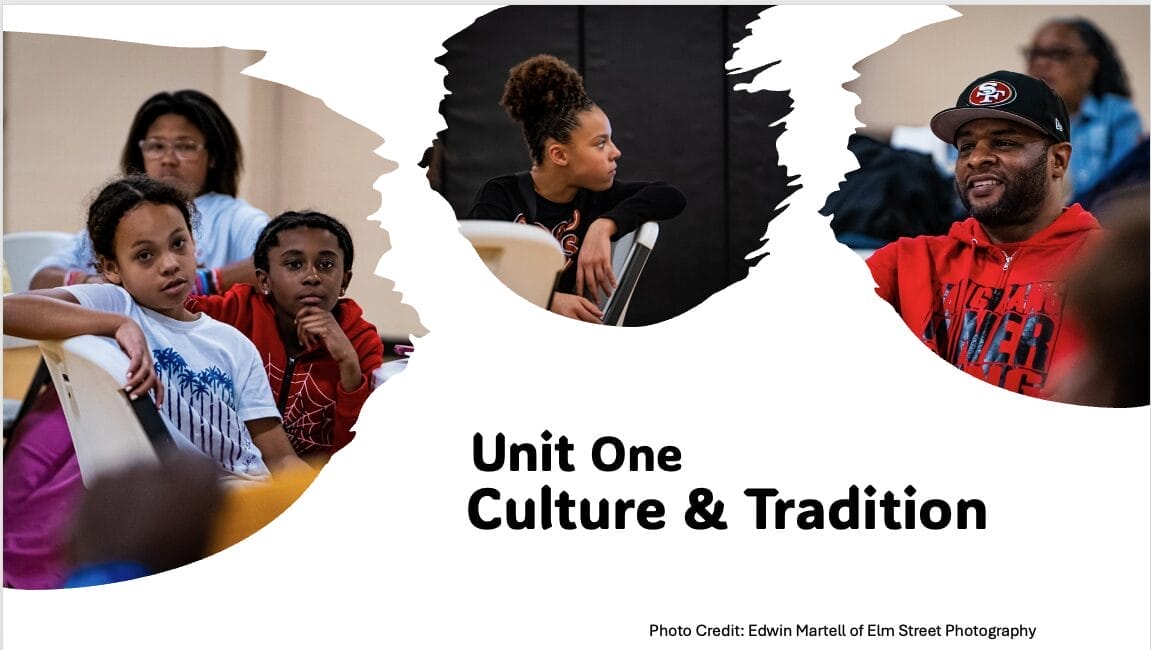
Unit One starts the curriculum with an introduction to the culture and traditions of the Blues People. The curriculum defines who the Blues People are, where they are from, and where the name comes from. It briefly introduces how we could document and create Blues songs. This unit also introduces foodways and family folklore—and the ways these are connected.
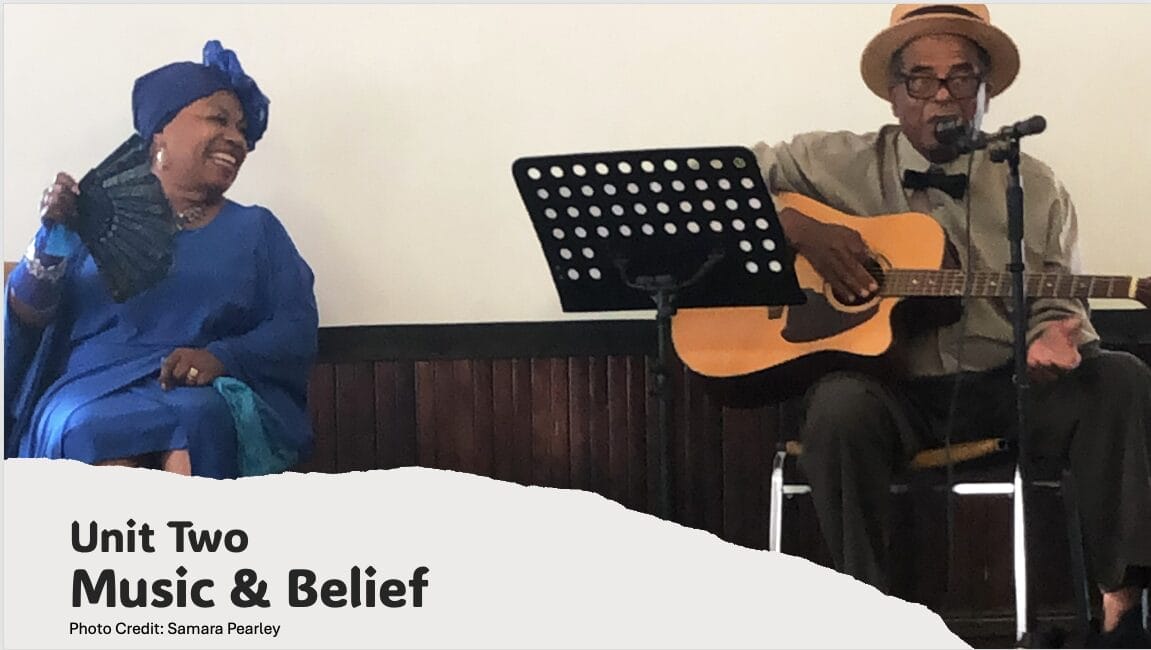
Unit Two focuses on the music and beliefs of the Blues People. Here, the course introduces the evolution of Blues from field hollers, slave seculars, prison songs, Black spirituals, and early concepts and ideas of the Blues. Discussion of church and secular beliefs can be incorporated into the lesson, exploring how these systems reflect and affect the expression of the Blues, varyingly embracing or frowning upon them. Here is a notable opportunity to engage students in a discussion about how the different generations in their families relate to one another’s musical preferences. Teachers can show the connection of rhythmic vocal styles between old-school pastors, Blues singers, and rappers.
Unit Two introduces some music theory and addresses styles of traditional Black music. Students learn about the I, IV, and V chord progression, a defining element of the Blues, as well as the characteristics of Blues vocal phrasing. They learn about the connections of related musical expressions to the daily life on plantations, farms, and other community contexts across the South.
Here, we also dive into motifs, legends, legend tripping, and ostension of the blues. A motif in a Blues song would be Muddy Waters talking about going to Louisiana to get a “Mojo” hand. It is a theme of the era for wooing women and an object of meaning. Students also learn about the symbolism of the crossroads and how this connects to the Blues via the legend of how Blues icon Robert Johnson acquired his musical prowess, the bizarre story of a man waiting at a highway intersection taking contracts for souls. Is it true? Well, many stories have been shared. Legend tripping and ostension in blues happen when enthusiasts look to experience the crossroads legend or act out stories of the blues, which include discussing the pilgrimages aspiring musicians take to see Bluesmen’s graves. (Depending on the age and depth of understanding of Black Southern spirituality, the lesson can discuss deeper connections to objects, magic, and Black Southern folk belief.)

Unit Three focuses on The Great Migration and provides the historical framework for exploring the movement of Black folklore and folklife throughout the U.S. Here, students learn about the movement of people and culture (including music and food traditions) from rural communities to urban regions, and the transformations that ensued. The lessons elaborate on the causes of this movement and how it sparked new musical styles that changed the trajectory of the American and global music business.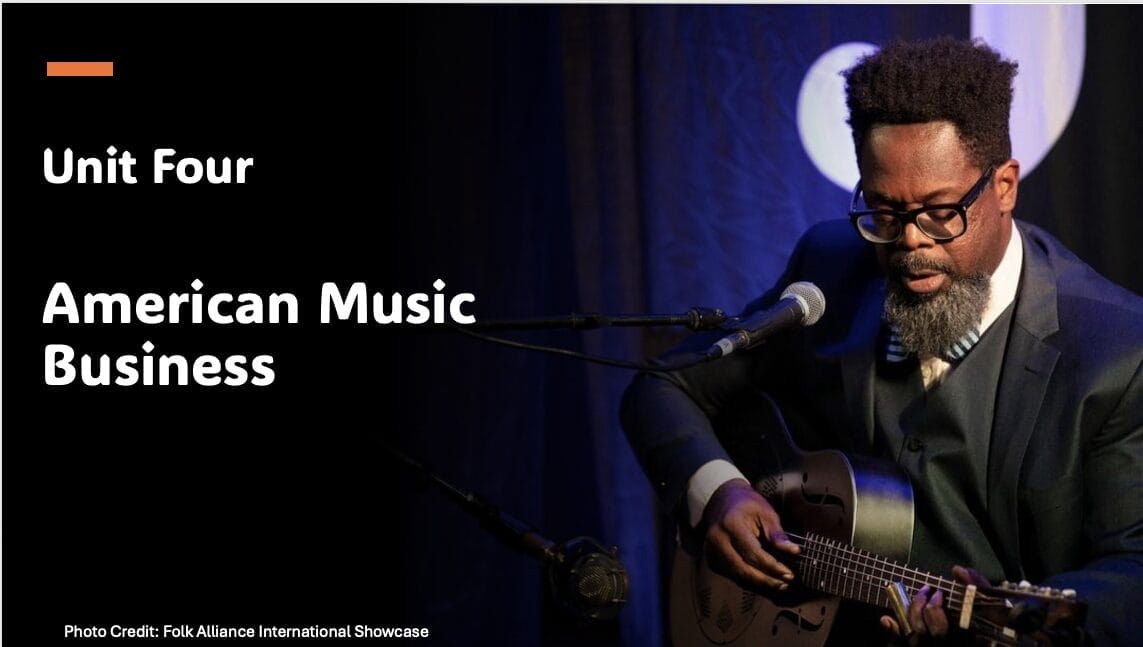
Unit Four discusses the music business, including how, historically, the industry racialized and commodified Black musical expressions. The lessons discuss the significance of women in Blues and the emergence of the Vaudeville and Minstrel industries, how they affected Black America, and how they inspired a new group of musicians.

Unit Five brings the first four units together, synthesizing what we’ve learned, and considers the generations and genres influenced and birthed by Blues, including Hip-Hop. We also begin comparing songs as we prepare to create original songs.
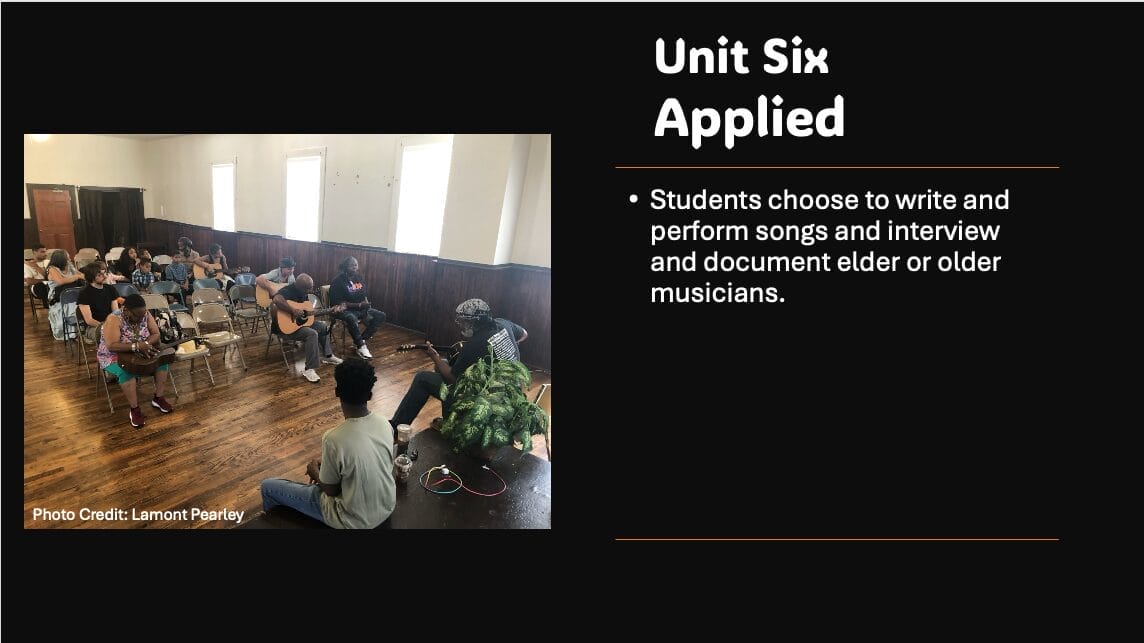
Unit Six brings everything together methodologically. Here, students choose to write and perform an original song, interview and document an elder or older musician, or both. The object is to apply everything learned in the earlier units to the fundamentals of song, performance, and field ethnography.
For those students opting to write a song, their lessons are organized as:
- Lesson 1: Blues Music Basics
- Lesson 2: The Feeling of the Blues
- Lesson 3: Singing and Playing
- Lesson 4: Writing a Blues Song
For those opting to document an elder, their lessons are organized as:
- Lesson 1: Selecting a narrator: Who are you going to interview, and what do you want to know
- Lesson 2: Planning your interview: Creating questions, being ready to pivot
- Lesson 3: Preparing your equipment: Using the camera
- Lesson 4: Preparing your equipment: Using recording equipment, including your phone

During Unit Seven, students come together to design a public program. This involves, for example, planning how a presentation during a festival would look, flow, and be produced. These can be scaled according to student level and time, as well as resources. Students could plan a mini festival for their school, classroom, or community organization. Or they could design sessions for a larger festival. The main objective is to provide students the opportunity to share the work they have completed during the course through publicly presenting performances and/or narrative sessions. Students learn the moving parts of preparing and producing public programs and presentations—and how to work in and interpret content in various formats.
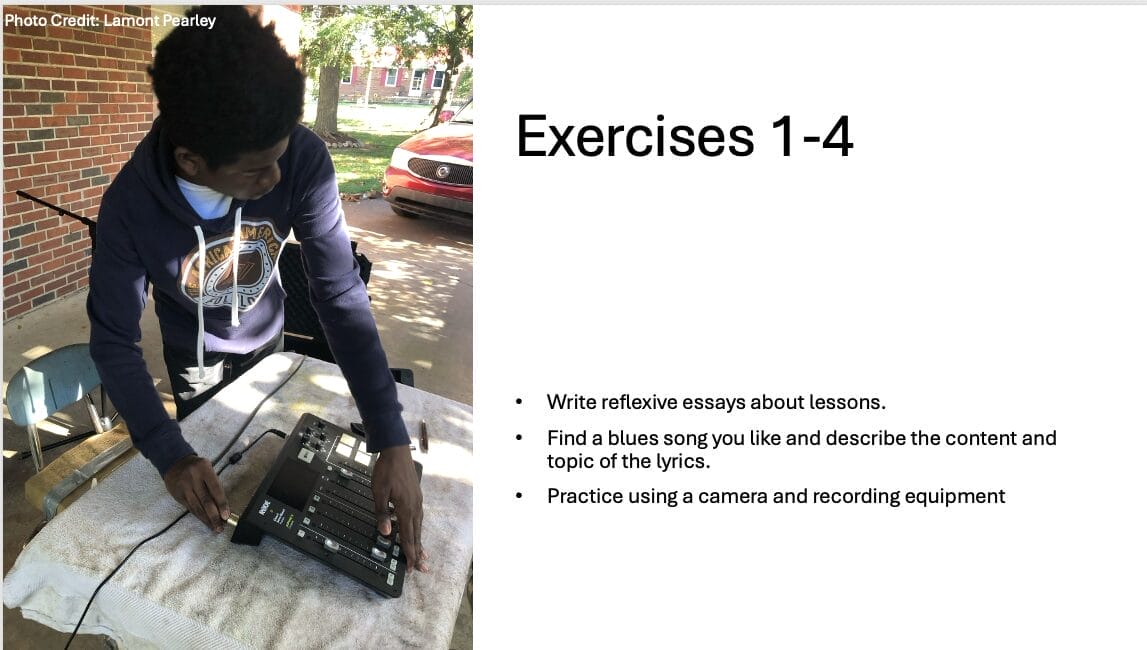
Teachers can spread the accompanying exercises throughout the seven units and the modules that are part of the units. In the exercises, students apply skills related to English, writing as a discipline, creative writing, language arts, history, social studies, and various subjects where writing is at the core. The exercises introduce and engage students and participants in reflexive and reflective essay writing, using recording equipment during interviews, and making connections between the content of the lessons and their own experiences and family/community heritage. The primary functions are to see what the student has understood thus far, help students develop basic field interview methods, and provide opportunities to workshop song ideas.
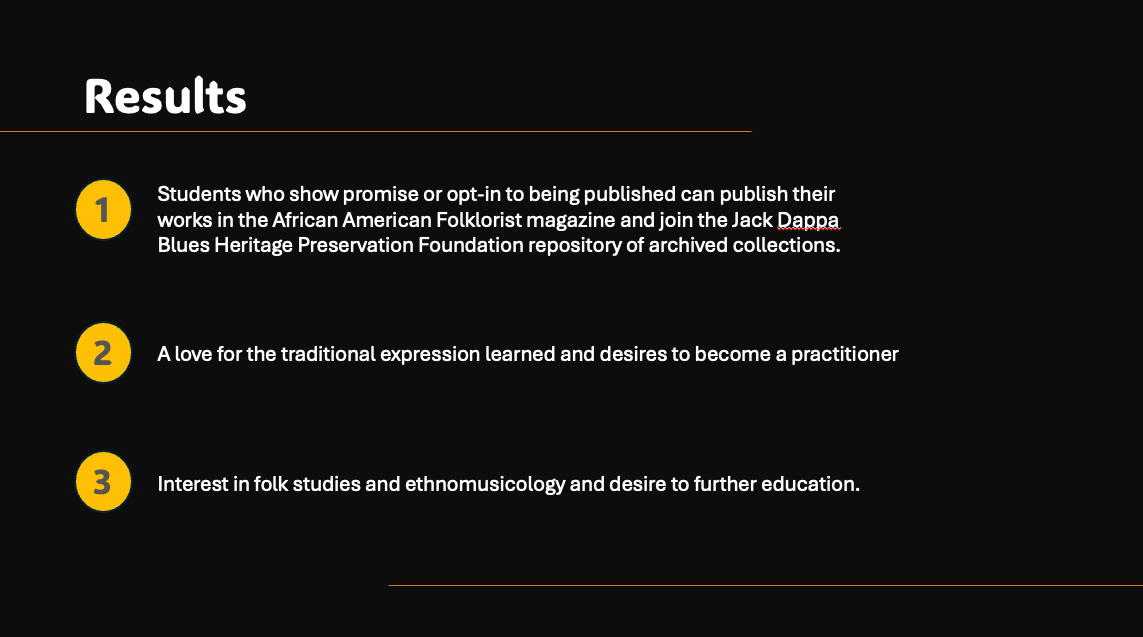
As fun as the curriculum may be, it should be results-driven. There are three significant results we are working toward:
- Students produce work that contributes to public knowledge. They may opt to publish their work in the African American Folklorist magazine and/or submit it to the Jack Dappa Blues Heritage Preservation Foundation repository of archived collections.
- Students have a love for the music they have learned about. Some may express a wish to become a practitioner.
- Students express interest in continuing to build their knowledge—through further Folk Studies and Ethnomusicology.
Along with the primary three, the development of the interest in research and writing, documenting and archiving, communication, problem solving, critical analysis, and conflict resolution are all assessments made at the end of every completed cycle.
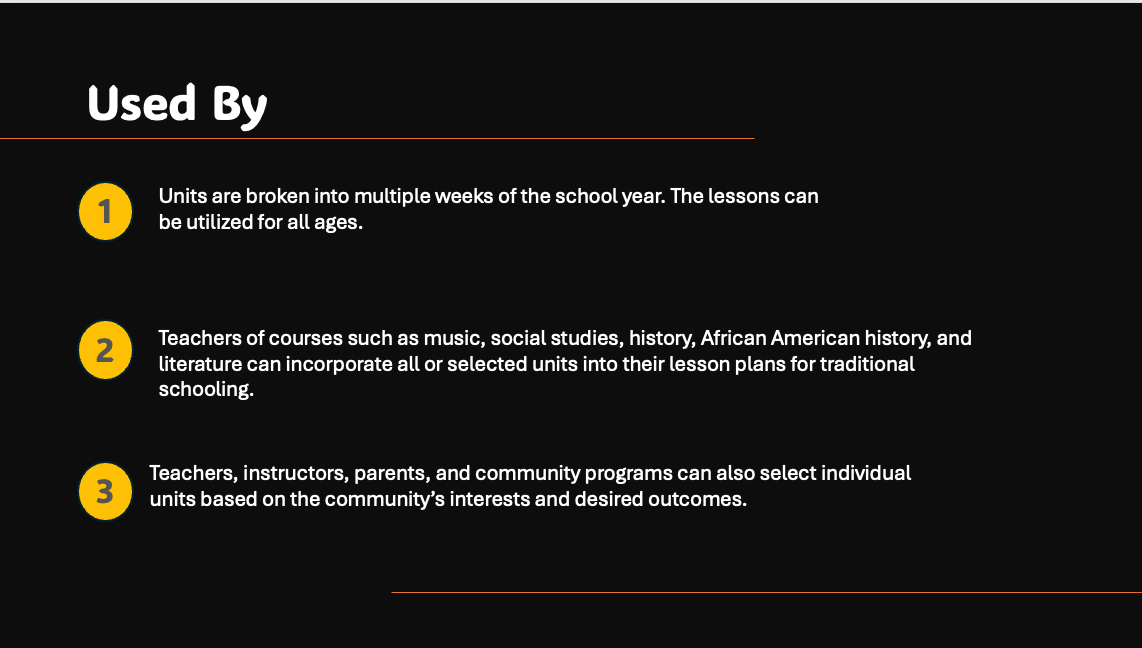
As a bring-it-home and clarification moment, we let folks know who can use this curriculum and for which age groups it is most appropriate. For example, teachers of courses such as music, social studies, history, African American history, and literature can incorporate all or selected units into their lesson plans for conventional schooling. However, as stated above, this has been designed for a range of educational settings, including homeschooled students and in programs at museums, libraries, or cultural organizations.
Lastly, if used in a conventional school setting, the lessons are based on the Kentucky Standards KRS 156.160 and 704 KAR 3:305.
The result of the year-long program curriculum is that students develop the communication skills necessary to function in a complex and changing world. From this deep dive into music—and its various contexts and meanings, we hope that students will:
- Have the knowledge to make economic, social, and political choices.
- Understand governmental processes as they affect the community, the state, and the nation, and how they affect them, their culture, and their community’s culture.
- Deepen self-knowledge and knowledge of shared traditions and expressions.
- Learn to work with others and make connections between aspects of their own traditions and heritage and those of their classmates.
- Learn and employ the methods of folklore and folklife.
 Lamont Jack Pearley is the Executive Director/ Founder of Jack Dappa Blues Heritage Preservation Foundation and the African American Folklorist magazine. He’s an applied folklorist, African American traditional music historian, Western Kentucky University Folk Studies Master’s Graduate, and traditional Country Blues practitioner inducted into the New York Blues Hall of Fame as a Great Blues Historian and TV/Radio Producer, and Great Blues Artist. Pearley works to conserve and sustain Blues and Black traditions through performance, documentation, and a repository of ethnographic interviews. He also works with communities to create sustainable cultural experiences and programming.
Lamont Jack Pearley is the Executive Director/ Founder of Jack Dappa Blues Heritage Preservation Foundation and the African American Folklorist magazine. He’s an applied folklorist, African American traditional music historian, Western Kentucky University Folk Studies Master’s Graduate, and traditional Country Blues practitioner inducted into the New York Blues Hall of Fame as a Great Blues Historian and TV/Radio Producer, and Great Blues Artist. Pearley works to conserve and sustain Blues and Black traditions through performance, documentation, and a repository of ethnographic interviews. He also works with communities to create sustainable cultural experiences and programming.
For more on the “Blues People, Music and Culture” program contact Lamont Jack Pearley at lamontjackpearley@jackdappabluesradio.tv.
URLs
Blues People Spotify https://open.spotify.com/playlist/5v1Ye8wZrvMoQXL3vE5BvJ?si=af9731433056439e
African American Folklorist magazine https://jackdappabluesradio.tv
Works Cited
Cone, James H. 1972. The Spirituals and the Blues: An Interpretation. New York: Seabury Press.
Jones, Leroi. 1963. Blues People: Negro Music in White America. New York: HarperCollins.
Work, III, John Wesley. 1940. American Negro Songs: 230 Folk Songs and Spirituals, Religious and Seculars. New York: Crown Publishers.
